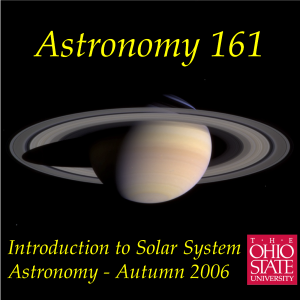
Astronomy 161 - Introduction to Solar System Astronomy
Education:Courses

Why do celestial objects appear to rise in the East and set in the West?
How does this depend on where you are on the Earth, or the time of year?
Today we set the heavens into motion, and look at the two most basic
types of celestial motions. Apparent daily motions are a reflection of
the daily rotation of the Earth about its axis. The apparent annual
motions are a reflection of the Earth's orbit around the Sun. To
describe the Sun's apparent annual motion, we introduce the Ecliptic,
the Obliquity of the Ecliptic, and four special locations along the
Ecliptic: the Solstices and Equinoxes. This will set the stage for much
of our discussions in rest of this section. Recorded 2006 Sep 27 in 100
Stillman Hall on the Columbus campus of The Ohio State University.
view more
More Episodes
Astronomy 141 Podcast Teaser
 2009-12-06
2009-12-06
 2009-12-06
2009-12-06
Lecture 45: Is Pluto a Planet?
 2006-11-30
2006-11-30
 2006-11-30
2006-11-30
Lecture 44: Comets
 2006-11-29
2006-11-29
 2006-11-29
2006-11-29
Lecture 42: Asteroids and Meteoroids
 2006-11-27
2006-11-27
 2006-11-27
2006-11-27
Lecture 41: Planetary Rings
 2006-11-22
2006-11-22
 2006-11-22
2006-11-22
Lecture 40: The Saturn System
 2006-11-21
2006-11-21
 2006-11-21
2006-11-21
Lecture 39: The Moons of Jupiter
 2006-11-20
2006-11-20
 2006-11-20
2006-11-20
Lecture 38: Uranus and Neptune
 2006-11-16
2006-11-16
 2006-11-16
2006-11-16
Lecture 37: Jupiter and Saturn
 2006-11-15
2006-11-15
 2006-11-15
2006-11-15
Lecture 35: The Deserts of Mars
 2006-11-13
2006-11-13
 2006-11-13
2006-11-13
Lecture 34: Venus Unveiled
 2006-11-09
2006-11-09
 2006-11-09
2006-11-09
Lecture 33: Battered Mercury
 2006-11-08
2006-11-08
 2006-11-08
2006-11-08
Lecture 32: The Origin of the Solar System
 2006-11-07
2006-11-07
 2006-11-07
2006-11-07
Lecture 31: The Family of the Sun
 2006-11-06
2006-11-06
 2006-11-06
2006-11-06
Lecture 30: The Moon
 2006-11-02
2006-11-02
 2006-11-02
2006-11-02
Lecture 29: The Earth's Atmosphere
 2006-11-01
2006-11-01
 1
1
 2006-11-01
2006-11-01
 1
1
Lecture 28: Inside the Earth
 2006-10-31
2006-10-31
 2006-10-31
2006-10-31
012345678910111213141516171819
Create your
podcast in
minutes
- Full-featured podcast site
- Unlimited storage and bandwidth
- Comprehensive podcast stats
- Distribute to Apple Podcasts, Spotify, and more
- Make money with your podcast
It is Free
- Privacy Policy
- Cookie Policy
- Terms of Use
- Consent Preferences
- Copyright © 2015-2024 Podbean.com



